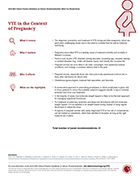ASH VTE Guidelines: Pregnancy
Pregnancy-associated VTE is a leading cause of maternal morbidity and mortality. The diagnosis, prevention, and treatment of pregnancy-associated VTE are particularly difficult because of the need to consider fetal, as well as maternal, well-being. These guidelines address these challenging issues.
Access the full guidelines on the Blood Advances website:
Guideline Implementation Tools and Resources
ASH guidelines are reviewed annually by expert work groups convened by ASH. Resources derived from guidelines that require updating are removed from the ASH website.
VTE Guidelines: What You Should Know
This one-page snapshot provides a high-level summary of the guidelines for diagnosis, prevention, and treatment of VTE during and after pregnancy, including considerations of fetal as well as maternal well-being. A snapshot of the full VTE guidelines is also available for download.
ASH Clinical Practice Guidelines App
The ASH Clinical Practice Guidelines App provides easy access to every recommendation from all guidelines published by ASH, including rationale for each recommendation, benefits and harms associated with each recommended course of action, and links to the complete evidence-to-decision tables used to develop the recommendations. This app is also available via web interface.
Download for iOS Download for Android
Pocket Guides
Available on iOS, Android, and via the web, the ASH Pocket Guides App includes all of ASH’s pocket guides, including the 2019 pocket guide on Venous Thromboembolism (VTE) in the Context of Pregnancy, which is available for order in printed format at the ASH Store.
- Venous Thromboembolism (VTE) in the Context of Pregnancy
ASH Store | Download PDF - not for distribution
Teaching Slides
Help your colleagues diagnose, manage, and treat VTE with the following teaching slides designed for easy dissemination:
- Teaching slides for VTE in the context of pregnancy
Powerpoint | PDF
Podcast
Listen to the podcast below to learn more about ASH's pregnancy guidelines.
External Resources
The following educational resource, developed by a third-party organization and based on the ASH VTE guidelines, is provided for reference. Please note that the American Society of Hematology does not endorse, nor is it responsible for, the content of this resource.
- Foundation for Women & Girls with Blood Disorders (FWGBD)
Webinar: Addressing the Prevention, Treatment and Management of VTE in Pregnancy: 2018 ASH VTE Clinical Practice Guidelines
VTE Patient Stories

Danielle Barrett found out she had venous thromboembolism (VTE) when she was 19 years old. She hadn’t been feeling well for a few weeks. One day, Danielle was heading out the door to go for a run, when she suddenly collapsed from a pulmonary embolism. “It was instant,” she says.
Fortunately, Danielle survived. While at the hospital, Danielle’s mother told the doctor that Danielle’s mother and uncles had antithrombin deficiency, a genetic risk factor for VTE. Danielle and her brother were tested, and they learned that both of them also had this risk factor.
When the time came to start a family, Danielle began talking to her doctors about the associated risks. However, she wasn’t worried because she knew a doctor would be monitoring every step. Throughout the course of the pregnancy, there were no issues and she successfully gave birth to a son.
Within five days after delivering her son, a clot began developing most likely from when Danielle was off of her blood thinners during delivery. Luckily, Danielle knew the signs, went to the emergency room and explained her symptoms. For Danielle, it was nerve-wracking caring for a newborn and experiencing another clot. Fortunately, she received the treatment she needed and made a full recovery. Four years later, she delivered her second son with her doctors modifying her treatment based on her previous pregnancy.
A few years after Danielle's first pregnancy, her brother told her he had been experiencing shortness of breath. By the time he went into the hospital, it was too late. He passed away from a pulmonary embolism.
While Danielle and her family have experienced a lot, her positivity remains. She implores women who have a history of clotting and are going through a pregnancy to get as much information as they can and to ask questions.
Patient Versions of the Guidelines
- Blood clots when you are pregnant or breastfeeding
- Heparin-induced thrombocytopenia
- Preventing a blood clot
- Testing for blood clots
- Things to know if you are taking a blood thinner to prevent blood clots
